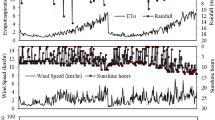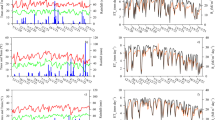Abstract
In the arid environment of southern Tunisia, FAO’s AquaCrop model version 4.0 has been calibrated to evaluate the effect of irrigation strategies with saline water on barley yield. Data sets during barley cropping seasons 2012 and 2013 in Médenine, southern Tunisia, were used to calibrate and evaluate this model. Barley canopy cover, grain yield, biomass production, and soil salinity and water content were simulated under three irrigation regimes. The RMSE, Willmott index of agreement (d), and r2 analysis showed good agreement between the simulated and observed data, especially for the biomass production and grain yield. The difference between observed and simulated grain yield under full irrigation was only 1% for the first and second seasons. The difference for biomass was around 2%. The trend of canopy cover was well simulated with slight over estimation in the beginning of the season for both seasons. Salinity stress parameters were adjusted to simulate the combined effect of drought and salinity stress where the electrical conductivity of water (ECw) was used as the indicator threshold of salinity instead of the saturated soil-paste extract (ECe) in this case. The model tended to overestimate the soil water content and the ECe but with reasonable statistical indices for total root zone soil water content (RMSE: 8.6–11 mm, d: 0.78–0.98) and for ECe (RMSE: 1.35–0.94 dS/m, d: 0.63–0.88).
Access this chapter
Tax calculation will be finalised at checkout
Purchases are for personal use only
Similar content being viewed by others
References
Andarzian B, Bannayanb M, Steduto P, Mazraeha H, Barati ME, Barati MA, Rahnamaa A (2011) Validation and testing of the AquaCrop model under full and deficit irrigated wheat production in Iran. Agric Water Manag 100(1):1–8
Araya A, Solomon H, Kiros MH, Afewerk K, Taddese D (2010) Test of AquaCrop model in simulating biomass and yield of water deficient and irrigated barley (Hordeumvulgare). Agric Water Manag 97:1838–1846
Ayers RS, Westcot DW (1976) Water quality for agriculture. Irrigation and Drainage Paper No 29 FAO Rome Italy
De Nys E, Raes D, Le Gal P, Cordeiro G, Speelman S, Vandersypen K (2005) Predicting soil salinity under various strategies in irrigation systems. J Irrig Drain Eng 131(4):351–357
El Mokh F, Nagaz K (2014) Impact of irrigation with saline water on yield, soil salinization and water productivity of barley in arid regions of Tunisia. Revue des Regions Arides 35(3):1217–1225
El Mokh F, Nagaz K, Masmoudi M, Ben Mechlia N (2015) Yield and water productivity of drip-irrigated potato under different nitrogen levels and irrigation regime with saline water in arid Tunisia. Am J Plant Sci 6:501–510
Farahani HJ, Izzi G, Oweis TY (2009) Parameterization and evaluation of the AquaCrop model for full and deficit irrigated cotton. Agron J 101:469–476
García-Vila M, Fereres E, Mateos L, Orgaz F, Steduto P (2009) Deficit irrigation optimization of cotton with AquaCrop. Agron J 101:477–487
Iqbal MA, Shen Y, Stricevic R, Pei H, Sun H, Amiri E, Rio S (2014) Evaluation of FAO Aquacrop model for winter wheat on the North China plain under deficit from field experiment to regional yield simulation. Agric Water Manag 135:61–72
Maas EV, Hoffman GJ (1977) Crop salt tolerance-current assessment. J Irrig. Drain Div ASCE 103:105–134
Nagaz K, Ben Mechlia N (2003) Etude de la consommation en eau et de la production de l’orge sous irrigation à l’eau salée. Revue des Régions Arides 14(1):17–29
Raes D (2002) BUDGET, a soil water and salt balance model: reference manual. K U Leuven Belgium 80 pp
Raes D, Geerts S, Kipkorir E, Wellens J, Sahli A (2006) Simulation of yield decline as a result of water stress with a robust soil water balance model. Agric Water Manag 81(3):335–357
Raes D, Steduto P, Hsiao TC, Fereres E (2012) Calculation procedures. AquaCrop version 4.0. FAO Land and Water Development Division, Rome
Raes D, Steduto P, Hsiao TC, Fereres E (2009) AquaCrop-The FAO crop model to simulate yield response to water. II. Main algorithms and software description. Agron J 101:438–447
Raes D, Van Goidsenhoven B, Goris K, Samain B, De Pauw E, El Baba M, Tubail K, Ismael J, De Nys E (2001) BUDGET, a management tool for assessing salt accumulation in the root zone under irrigation. In 4th Inter regional conference on environment-water, ICID 27–30 August, Fortaleza, Brazil: 244–252
Salemi HMA, Lee TS, Mousavi SF, Ganji A, Yusoff MK (2011) Application of AquaCrop model in deficit irrigation management of Winter wheat in arid region. Afr J Agric Res 610:2204–2215
Sghair N, Masmoudi M, Ben Mechlia N (2014) Paramétrage du modèle Aquacrop pour la simulation du blé dur. Revue des Régions Arides 35(3):1351–1360
Steduto P, Hsiao TC, Raes D, Fereres E (2009) AquaCrop-The FAO crop model to simulate yield response to water. I. Concepts. Agron J 101:426–437
Vanuytrecht E, Raes D, Steduto P, Hsiao TC, Fereres E, Heng LK, Vila Garcia M, Moreno (2014) Aquacrop: FAO’S crop water productivity and yield response model. Environ Model Softw. 1–10. doi:10.1016/j.envsoft.2014.08.005
Wang Xiangxiang W, Quanjiu W, Jun F, Qiuping F (2013) Evaluation of the AquaCrop model for simulating the impact of water deficits and different irrigation regimes on the biomass and yield of winter wheat grown on China’s Loess Plateau. Agric Water Manag 129:95–104
World bank (2014) http://www.worldbank.org/html/cgiar/25years/mand.html
Author information
Authors and Affiliations
Corresponding author
Editor information
Editors and Affiliations
Rights and permissions
Copyright information
© 2017 Springer International Publishing AG
About this chapter
Cite this chapter
El Mokh, F., Vila-Garcia, Nagaz, K., Masmoudi, M.M., Ben Mechlia, N., Fereres, E. (2017). Calibration of AquaCrop Salinity Stress Parameters for Barley Under Different Irrigation Regimes in a Dry Environment. In: Ouessar, M., Gabriels, D., Tsunekawa, A., Evett, S. (eds) Water and Land Security in Drylands. Springer, Cham. https://doi.org/10.1007/978-3-319-54021-4_5
Download citation
DOI: https://doi.org/10.1007/978-3-319-54021-4_5
Published:
Publisher Name: Springer, Cham
Print ISBN: 978-3-319-54020-7
Online ISBN: 978-3-319-54021-4
eBook Packages: Earth and Environmental ScienceEarth and Environmental Science (R0)




